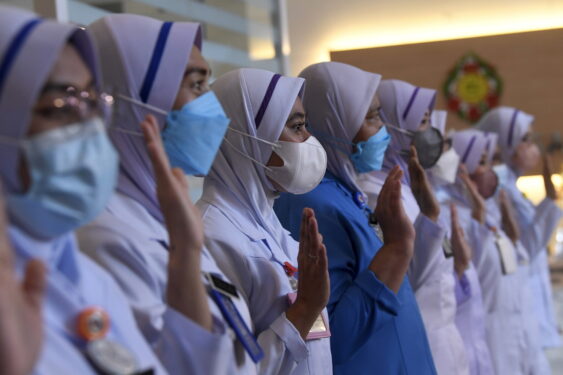By Lee Heng Guie
PUBLIC generally felt frustrated by the Government’s response to this pandemic, and wasted an opportunity to suppress the virus in 4Q 2020 when cases were starting to rise, and instead chose to allow inter-state travel and some form of lackadaisical attitude in the compliance of standard operating procedure (SOP) in public social gatherings/events, restaurants and crowded places.
High prevalence of slackening SOP compliance, including social distancing, inadequate testing and contact tracing created more opportunities for the spreading of virus at a worrying pace.
Our national healthcare facilities have reached an inflection point as the third wave of COVID-19, which started on Sept 20, 2020 has been spreading fast and ballooned to climb past 2,000-3,000 mark each day in recent weeks, have overwhelmed the healthcare system.
The rapid virus spread and mounting strains on the healthcare system have left the Government with no choice to declare the national emergency and implement three stages of movement restrictions according to the level of infection risk by states for a two-week period (Jan 13 until Jan 26, 2021): (i) Movement control order (MCO) in Penang, Selangor, Federal Territory (Kuala Lumpur, Putrajaya and Labuan), Malacca, Johor and Sabah; (ii) Conditional MCO (CMCO) in Pahang, Perak, Negeri Sembilan, Kedah, Terengganu and Kelantan; and (iii) Recovery MCO (Perlis and Sarawak).
With the distribution of vaccines and vaccination program in some advanced economies towards Dec 2020, and also the welcome news on the supply of vaccines for Malaysians in Feb 2021, there is increasing sense of optimism that vaccines could return Malaysia to normal by 1H 2021.
However, cautious optimism is being tempered by serious concerns about the continued surge in infection has placed the country’s healthcare system under heavy pressure.
If uncontrollable, in many ways it is even tougher for hospitals and healthcare front liners to cope with the surge in infection numbers while trying to clear the backlog on non-urgent operations and procedures cancelled or deferred in the previous waves.
While waiting for the distribution of vaccines and mass vaccination to take place, probably end of February or in March this year, the next two-three months will be critical to Malaysia’s COVID-19 flight and scheduled vaccination program.
Vaccinating as many people as quickly as possible will be key to this containment of virus spread. But vaccinating everyone will take time, which is why a tougher movement restriction is necessary in those highly risk states to reduce a wide spread community transmission.
Mass testing and pooled testing, effective contact tracing strategy as well as supported isolation are central to controlling the virus. Most importantly, we must stop any opportunities to infect others.
Hence, we need to strictly follow and enforce these new restrictions, continue to practise social distancing and avoid crowded spaces, wearing masks, hand sanitising and do our best to avoid getting infected and passing the virus on.
How our economy cope with these restrictions? In particular, Penang, Selangor, Federal Territory (Kuala Lumpur, Putrajaya and Labuan), Malacca, Johor and Sabah, together contributed a combine 66.3% of total national GDP output.
The inter-state travel bans and two weeks’ MCO for these states would result in some loss in output and demand. It is estimated that two weeks MCO and CMCO will reduce GDP by 0.5% percentage points. If we assume one-month MCO/CMCO, it will reduce our baseline estimate to 4.0% from 5.0% previously in 2021 (estimated -5.5% and -5.8% in 2020).
The chances are that we will cope, but at a short-term cost, depending on the duration of MCO/CMCO. The cost will be even larger and a long-lasting impact for not doing good enough to balance the health risk prevention and supporting the economy.
It is a tough health-economic judgment to force on these latest movement control measures. Health performance and economic performance are interlinked, and hence, a sustained economic recovery is only possible if the pandemic continues to be suppressed and contained.
The domestic economy is healing and has yet to be restored to a full capacity as the pandemic has disproportionately impacted the services sector versus the manufacturing sector due to social distancing measures and changes in consumer behaviour.
Businesses across the retail, hospitality and leisure sectors have endured many months of challenging revenue stream and will be slowly on the mend, followed by a cycle of limited re-openings and more closures. Cash flow problem remains a constraint.
In addition, jobless rate still at high level of 4.8% at end-November 2020 with about 760,000 persons unemployed. The construction sector is likely to be dampened by the shortage of foreign workers amid the compulsory testing of foreign workers.
The implementation of emergency must be carefully managed and enforced in a transparent manner and well communicated to instil confidence and ease investors’ uncertainty. More importantly, it must be lifted when the emergency decree has served its purpose as a protracted emergency period would undermine private investment prospects.
We recognize that the shape of Malaysia’s economic growth in 2021 is dependent on the development of infection rates and vaccination, the effective implementation of Budget 2021’s spending programs and cash assistance, consumer and business confidence as well as the economic performance of Malaysia’s major trading partners. In this critical time, a quick implementation and disbursement of the 2021 Budget’s allocation and programs is vital.
More financial relief/aid to come? The continued one-off cash assistance, on-going enhanced targeted loan repayment assistance, the EPF Account 1 (i-Sinar) withdrawal facility, and other financial assistance/grant for small and medium sized enterprises (SMEs), including the wage subsidy program are expected to soften the impact.
Some form of one-off financial aid for small traders and micro businesses; more compassionate support from banks in loan repayment assistance; rental relief; electricity discount; and payment of balance of tax for year of assessment (YA) 2020-2021 in three monthly instalments can be considered. Also, Bank Negara Malaysia may consider to cut its policy rate by 25 basis points to 1.50% to provide some insurance against sentiment risk. – Jan 13, 2021
Lee Heng Guie is the executive director of the think-tank, Socio-Economic Research Centre (SERC).
The views expressed are solely of the author and do not necessarily reflect those of Focus Malaysia.










